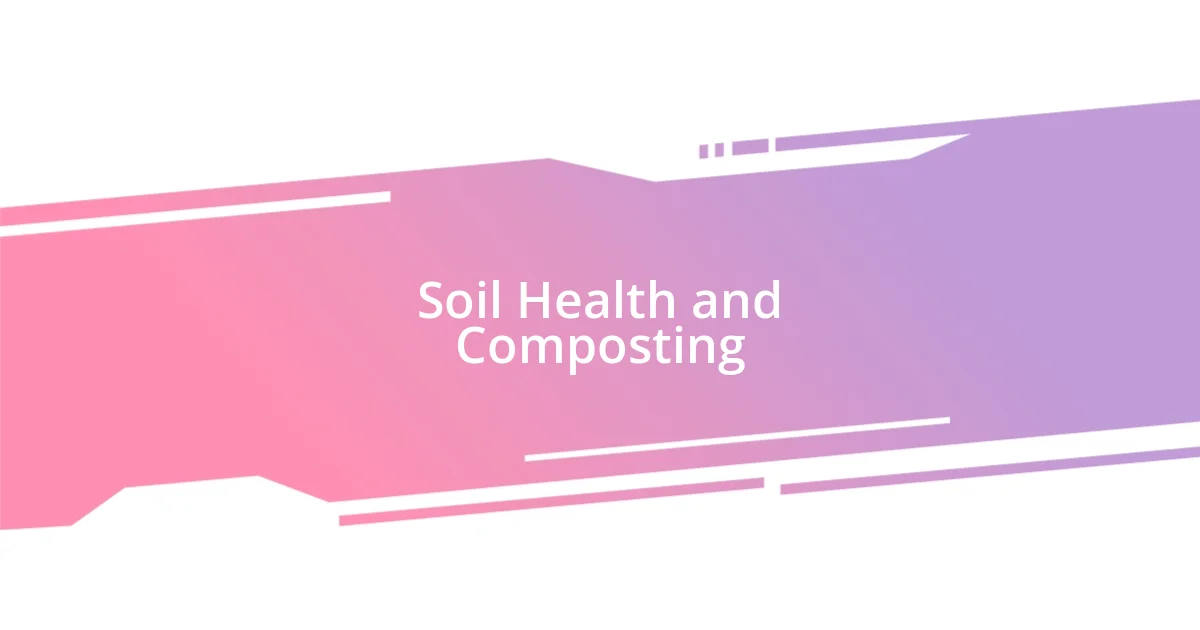Key takeaways:
- Implementing sustainable practices such as choosing native plants, conserving water, and composting enriches both the environment and personal gardening experiences.
- Sustainable landscaping benefits include increased biodiversity, reduced resource use, improved soil health, and enhanced resilience against climate change.
- Eco-friendly materials and natural maintenance techniques contribute to long-term landscape health and ecological harmony, creating a thriving garden ecosystem.

Understanding Sustainable Landscaping
Sustainable landscaping goes beyond mere aesthetics; it’s about fostering a harmonious relationship between our outdoor spaces and the environment. I remember the first time I applied native plants to my garden. It felt like giving back to the ecosystem, and seeing the butterflies and birds thrive made the effort worthwhile. Isn’t it inspiring to think about how simple choices can create a haven for local wildlife?
When I think of sustainable landscaping, I often reflect on water conservation. A few years ago, I installed a rain garden, and it was such a rewarding experience. This approach not only captures and filters runoff but also provides a unique, vibrant space in my yard. Have you ever considered how much natural beauty and function you can pack into a landscape designed with sustainability in mind?
Understanding the principles of sustainable landscaping is pivotal for creating environments that endure. It involves thoughtful choices like using organic fertilizers and composting, which can significantly reduce chemical runoff into waterways. I find it incredibly fulfilling to know that every little effort I make contributes to healthier soil and a cleaner planet. How about you—what sustainable practices have you thought about incorporating into your landscaping?

Benefits of Sustainable Landscaping
Embracing sustainable landscaping not only enhances the beauty of our surroundings but also brings a multitude of benefits that resonate with both personal and environmental well-being. For instance, I experienced a delightful surprise when I noticed a significant decrease in my water bill after implementing xeriscaping techniques. It’s amazing how these choices not only conserve resources but also create a landscape that thrives with minimal maintenance. I find that the sense of accomplishment from engaging in eco-friendly practices adds an extra layer of joy to the gardening experience.
Here are some key benefits of sustainable landscaping:
- Biodiversity Boost: Attract pollinators and other wildlife with native plants, contributing to local biodiversity.
- Resource Efficiency: Reduced water and chemical use means lower bills and a smaller environmental footprint.
- Soil Health: Implementing composting and organic practices improves soil quality over time, enhancing plant growth.
- Climate Resilience: Sustainable designs can better withstand extreme weather, leading to a more resilient garden.
- Aesthetic Appeal: Thoughtfully designed landscapes create visually stunning environments that also serve ecological purposes.
Every time I step into my garden, I feel both the peace of nature and the pride of knowing I’m making choices that matter. How wonderful is it to contribute to something larger than ourselves through our everyday choices?

Choosing Native Plants Wisely
Choosing native plants is a transformative practice in sustainable landscaping. I recall visiting a local nursery specifically for native species; the vibrant colors and unique shapes of these plants were captivating. I never expected that selecting local flora would not only enhance my garden’s beauty but also reduce my maintenance time dramatically. Isn’t it comforting to know that the plants you choose are already adapted to your environment?
When you opt for native plants, you’re also choosing resilience and ecological harmony. For example, in my own garden, I planted some milkweed. Not only did it bring stunning blooms, but it also became a magnet for monarch butterflies. Watching them thrive and knowing I’m supporting their life cycle fills me with a sense of purpose. Who wouldn’t feel joy in witnessing nature flourish right in their backyard?
It’s important to consider the right native plants for your specific region and soil type. I once ended up with a beautiful variety that thrived in my sandy soil, and the contrast it created with the lush greenery was simply stunning. I learned to embrace diversity in my choices. Have you thought about the various native options that might suit your space?
| Plant Type | Description |
|---|---|
| Milkweed | Supports monarch butterflies and has beautiful blooms. |
| Coneflower | Attracts pollinators with its vibrant petals and drought tolerance. |
| Black-eyed Susan | Hardy, easy to grow, and offers bright yellow flowers throughout summer. |
| Switchgrass | Helps prevent erosion while providing height and texture to landscapes. |

Water Conservation Techniques
Water conservation is a critical aspect of sustainable landscaping that I’ve come to appreciate deeply. One effective method I’ve implemented is the use of rain barrels to collect water from my roof. Seeing those barrels fill up during a rainstorm is almost exhilarating. I often wonder how much water I was wasting before I started this practice. Using this collected rainwater for my garden has not only reduced my water bill but also given me a more sustainable source for irrigation.
Mulching is another technique that I’ve found particularly rewarding. Initially, I was skeptical about how a simple layer of organic material could make a difference. However, I’ve experienced firsthand how it helps retain moisture in the soil and suppress weeds. After applying mulch, I noticed that my plants thrived even during dry spells. Have you tried using mulch in your garden? You might be surprised at how little effort it takes to create such a huge impact!
Moreover, I’ve discovered the power of drip irrigation systems. Setting one up in my garden seemed daunting at first, but once I got the hang of it, the benefits were clear. I could target the roots of my plants directly, minimizing waste and maximizing efficiency. I remember the first time I watched it work. It was amazing to see water trickle gently to where it was needed most. Finding joy in a well-watered plant feels almost magical, doesn’t it? Water conservation techniques like these have truly transformed my approach to gardening.

Soil Health and Composting
Soil health is the foundation of any thriving garden, and I’ve learned that composting plays a crucial role in nurturing it. After starting my own compost pile, I was amazed to see how kitchen scraps and yard waste transformed into rich, dark gold over time. It felt a bit like magic—taking something destined for the landfill and turning it into a nutrient powerhouse for my plants. Have you ever experienced that satisfaction of creating something beautiful from what was once considered waste?
I also discovered that the microbial life in healthy soil is just as important as the nutrients it holds. When I added my homemade compost to the garden, I noticed a significant increase in earthworm activity. I couldn’t help but marvel at the way the soil became alive with movement—evidence of a thriving ecosystem. There’s a certain joy in digging your hands into rich, crumbly soil and feeling those little creatures bustling about. Isn’t it comforting to realize that a vibrant garden is a community effort?
Moreover, I’ve experimented with layering green and brown materials in my compost to balance nitrogen and carbon. This approach has not only accelerated the composting process but has also allowed me to customize the nutrient content for various areas of my garden. The first time I applied this nutrient-rich compost, the difference in plant health was striking. I still remember standing back, admiring how the colors popped and the growth flourished. Isn’t it incredible how such simple practices can significantly boost soil health and ultimately your garden’s success?

Eco-Friendly Landscaping Materials
When it comes to eco-friendly landscaping materials, I’ve found that choosing the right products can make a world of difference. For instance, I recently switched to using reclaimed wood for my garden beds. The rustic look adds character, and knowing that I’m giving a second life to something otherwise discarded feels incredibly fulfilling. Have you ever considered how materials’ origins can impact your landscape’s sustainability?
I also think that native plants deserve a spotlight in any eco-conscious garden. By selecting species that are naturally suited to my area, I’ve noticed significant improvements in bioluminescence—clearer air, healthier soil, and while I can’t prove it, even my mood seems brighter. The beauty of this approach is that these plants require less maintenance and water, creating a more resilient garden. What joy it brings me to watch the local pollinators thrive in my little ecosystem!
Another standout for me has been using permeable pavers for walkways. These materials allow rainwater to pass through, reducing runoff and promoting groundwater recharge. I remember my first rainy day post-installation; it was satisfying to see water soaking into the pavers instead of pooling. It felt like I was contributing to a larger environmental effort, one small patio step at a time. Who knew home improvement could feel so rewarding?

Maintenance Practices for Longevity
Maintaining a sustainable landscape goes beyond the initial setup; it’s all about consistent care. I make it a point to schedule seasonal tasks like mulching and pruning. I remember the first time I mulched my garden beds—it was like giving my plants a protective blanket during the colder months. Have you seen how refreshed plants look after a good mulching? It’s a simple step that really extends the life of your garden.
I also believe in the power of natural pest control methods. A while ago, I noticed some aphids trying to take over my roses. Instead of reaching for harsh chemicals, I released ladybugs, and within no time, those little champions had taken care of the problem. It was a joy to witness nature’s balance at work—that moment reinforced my commitment to sustainable practices. Don’t you find it fascinating how some of the best solutions are often right under our noses?
Another crucial aspect that I’ve integrated into my routine is water conservation. Setting up a rainwater collection system was a game changer for me. I can clearly recall my first rainfall after installation; watching that barrel fill up felt like a victory. Now I have a free resource to water my garden, and it reduces the demand on municipal water sources. It’s rewarding to know that I’m not only helping my plants but also making a positive impact on local water conservation efforts. Isn’t it amazing what a little thoughtfulness can achieve in your landscaping journey?












